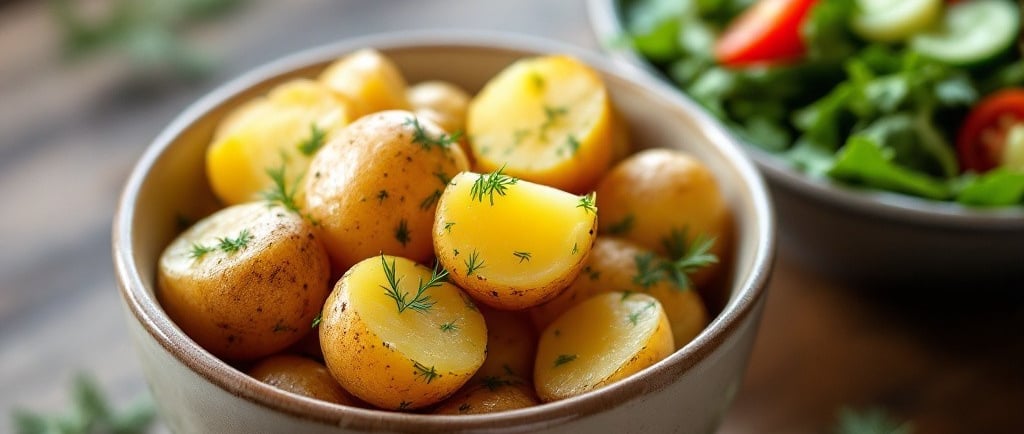New Potatoes with Dill
New potatoes are a wonderful, versatile vegetable to include in your meals, especially during their short spring-summer season. They are delicious and nutritious, with a delicate flavor that pairs well with a variety of herbs, spices, and proteins.
GLUTEN FREEEASY TO MAKEVEGETARIANSIDE DISH
3/11/20254 min read


Origin and History of New Potatoes:
New potatoes are simply young, early-harvested potatoes that are picked before they have had time to fully mature. They are often smaller, with thin, tender skins, and have a creamy texture and sweet flavor. The origin of potatoes goes back to South America, particularly the Andes region (modern-day Peru, Bolivia, and Chile). The indigenous peoples there first domesticated potatoes around 8,000 to 10,000 years ago.
The concept of "new potatoes" refers to varieties that are harvested early in the growing season. These were historically prized because they provided a fresh and nutritious food source before the main harvest of mature potatoes in late summer or early fall. Over time, with the expansion of potato cultivation, new potatoes became an important part of European and later American cuisines.
Health Benefits of New Potatoes:
New potatoes have many of the same health benefits as regular potatoes but with a slightly different nutritional profile due to their youth. Here’s a breakdown:
Low in Calories: New potatoes are a healthy, low-calorie food that makes for a good addition to weight management plans.
Rich in Vitamin C: Like mature potatoes, new potatoes are rich in vitamin C, which supports the immune system, skin health, and wound healing.
High in Potassium: Potatoes, including new potatoes, are a great source of potassium, which helps maintain healthy blood pressure and heart function.
Fiber Content: New potatoes contain fiber, especially if you eat the skin. This promotes digestion and gut health.
Antioxidants: New potatoes have antioxidants like vitamin C and certain phytonutrients, which help combat oxidative stress in the body.
When New Potatoes Are in Season:
New potatoes are typically in season in late spring to early summer, depending on your region. In the Northern Hemisphere, they are usually harvested from late April to June, but the exact timing can vary based on the climate and potato variety. They are often available earlier in warmer climates and later in cooler climates.
Tips on How to Cook New Potatoes:
Do Not Peel: New potatoes have very thin skins, which are edible and nutritious. Keep the skins on for the best texture and flavor.
Boil or Steam Gently: Since new potatoes are tender, boil or steam them gently to avoid mushiness. They should remain firm when cooked.
Season Well: These potatoes have a mild flavor, so be generous with seasonings. Fresh herbs, such as parsley, rosemary, or thyme, work particularly well.
Roasting: Toss new potatoes with olive oil, salt, and pepper, and roast them at 400°F (200°C) for about 25-30 minutes until crispy on the outside and tender inside.
New Potatoes with Dill Recipe
New potatoes and dill are a perfect match; the delicate, mild flavor of the potatoes is beautifully complemented by the subtle hint of dill, resulting in a balanced dish that has become a beloved classic in many kitchens.
Yield: 3 servings
Instructions:
1 ½ lb. small new potatoes, cut into 4
1 bay leaf
1 tsp. kosher salt
2 Tbsp. Olive oil
1 tsp. dill weed
Instructions:
Prepare the Potatoes: Gently scrub the new potatoes under cold water (you can leave the skin on).
Boil the Potatoes: Place the new potatoes in a pot of salted water. Bring to a boil and cook for about 10-12 minutes or until fork-tender.
Drain and Toss: Drain the potatoes and return them to the pot. While still warm, toss with olive oil, and fresh dill.
Serve: Warm or at room temperature.
Note:
When you cut raw potatoes, they often turn brownish or black due to a chemical reaction known as oxidation. This happens when the potato's flesh is exposed to air, causing the enzymes in the potato (mainly polyphenol oxidase) to react with oxygen. This reaction leads to the production of quinones, which then polymerize into melanin – the same pigment that causes skin to tan when exposed to sunlight. The melanin gives the cut potatoes their brown or black color.
How to Prevent Potatoes from Turning Brown or Black:
Submerge in Water: After cutting your potatoes, immediately place them in a bowl of cold water. The water prevents the potatoes from coming into contact with oxygen, slowing down the oxidation process. You can keep them submerged until you are ready to cook them, and they will remain fresh-looking.
Suggestions on How to Eat and Pair New Potatoes:
As a Side Dish: New potatoes pair well with grilled meats, roasted chicken, or fish. Serve them with a salad.
Who Should Not Eat New Potatoes?
There are a few groups of people who may need to avoid new potatoes, or any type of potato, under certain circumstances:
People with Nightshade Sensitivities: Potatoes belong to the nightshade family, which also includes tomatoes, peppers, and eggplants. People who are sensitive to nightshades may experience inflammation, joint pain, or digestive issues when consuming potatoes.
People with High Blood Sugar: Potatoes, including new potatoes, are relatively high in carbohydrates and can cause a spike in blood sugar levels. People with diabetes or those managing insulin sensitivity should monitor their portion sizes or opt for lower-carb alternatives.
People with Kidney Issues: While potatoes are high in potassium, which is generally beneficial, individuals with kidney disease or those on potassium-restricted diets may need to avoid or limit their consumption of high-potassium foods like new potatoes.
Important: If you have any doubts about incorporating this food into your diet, it is always a good idea to consult with your dietician or doctor.
Plenitaste
Inspiring healthy, global recipes for everyone.
contact me:
Recipe
plenitaste@gmail.com
© 2025. All rights reserved.
